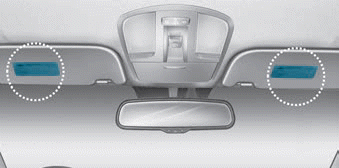Hyundai Ioniq: Safety system of your vehicle / Air bag - Advanced supplemental restraint system

1. Driver's front air bag
2. Passenger's front air bag
3. Side air bag
4. Curtain air bag
5. Driver's knee air bag
This vehicle is equipped with an Advanced Supplemental Air Bag System for the driver's seat and front passenger's seats.
The front air bags are designed to supplement the three-point seat belts. For these air bags to provide protection, the seat belts must be worn at all times when driving.
You can be severely injured or killed in an accident if you are not wearing a seat belt. Air bags are designed to supplement seat belts, but do not replace them. Also, air bags are not designed to deploy in every collision. In some accidents, the seat belts are the only restraint protecting you.
WARNING
AIR BAG SAFETY PRECAUTIONS
ALWAYS use seat belts and child restraints - every trip, every time, everyone! Even with air bags, you can be seriously injured or killed in a collision if you are improperly belted or not wearing your seat belt when the air bag inflates.
NEVER place a child in any child restraint or booster seat in the front passenger seat. An inflating air bag could forcefully strike the infant or child causing serious or fatal injuries.
ABC - Always Buckle Children under age 13 in the back seat. It is the safest place for children of any age to ride. If a child age 13 or older must be seated in the front seat, he or she must be properly belted and the seat should be moved as far back as possible.
All occupants should sit upright with the seatback in an upright position, centered on the seat cushion with their seat belt on, legs comfortably extended and their feet on the floor until the vehicle is parked and is turned off. If an occupant is out of position during an accident, the rapidly deploying air bag may forcefully contact the occupant causing serious or fatal injuries.
You and your passengers should never sit or lean unnecessarily close to the air bags or lean against the door or center console. Move your seat as far back as possible from front air bags, while still maintaining control of the vehicle. The U.S. National Highway Traffic Safety Administration (NHTSA) recommends that drivers allow at least 10 inches (25 cm) between the center of the steering wheel and the chest.
- Where Are the Air Bags?
- How Does the Air Bag System Operate?
- What to Expect After an Air Bag Inflates
- Occupant Classification System (OCS)
- Why Didn't My Air Bag Go Off in a Collision?
- SRS Care
- Additional Safety Precautions
- Air Bag Warning Labels
 Securing a child restraint with lap/shoulder belt
Securing a child restraint with lap/shoulder belt
When not using the LATCH system, all child restraints must be secured to a vehicle
rear seat with the lap part of a lap/shoulder belt.
WARNING
ALWAYS place a rear-facing child restraint in the rear seat of the vehicle...
 Where Are the Air Bags?
Where Are the Air Bags?
Driver's and passenger's front air bags
Your vehicle is equipped with a Advanced Supplemental Restraint System (SRS)
and lap/shoulder belts at both the driver and passenger seating positions...
Other information:
Hyundai Ioniq (AE) 2017-2025 Service Manual: Antenna Coil. Repair procedures
Removal1.Disconnect the negative (-) battery terminal.2.Remove the steering column shroud panel.(Refer to Body - "Steering Column Shroud Panel")3.Disconnect the 6P connector (B) of the coil antenna and then remove the coil antenna (A) after loosening the screw...
Hyundai Ioniq (AE) 2017-2025 Service Manual: Pre-Charge Resistor. Description and operation
D..
Categories
- Manuals Home
- 1st Generation Ioniq Owners Manual
- 1st Generation Ioniq Service Manual
- Tilt Steering / Telescope Steering
- If the 12 Volt Battery is Discharged (Hybrid Vehicle)
- Temperature control
- New on site
- Most important about car
Air Bag Warning Labels

Air bag warning labels, required by the U.S. National Highway Traffic Safety Administration (NHTSA), are attached to alert the driver and passengers of potential risks of the air bag system. Be sure to read all of the information about the air bags that are installed on your vehicle in this Owners Manual.
